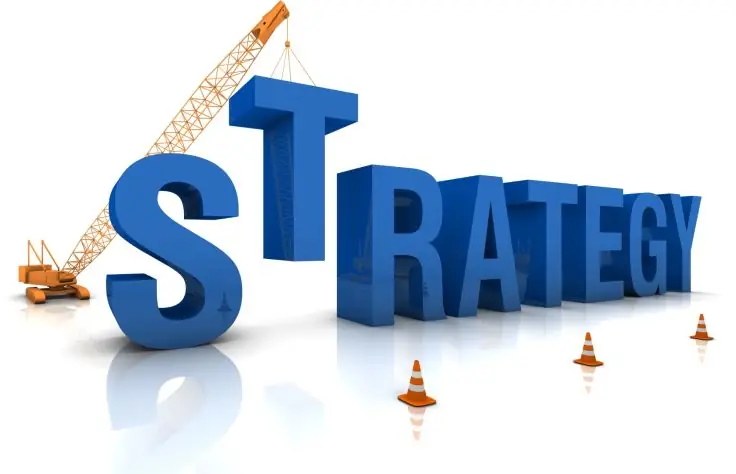2025 Author: Howard Calhoun | [email protected]. Last modified: 2025-06-01 07:12:56
Strategic planning of a company is one of the steps of successful business development. This truth began to form from the beginning of the 20th century. And the idea has evolved rapidly over the course of 100 years. The first divisions involved in long-term and medium-term planning were not permanent departments or divisions in this kind of activity. Annual financial estimates - this ended the strategic build.

Founder of the idea
Igor Ansoff, a native of Russia who has lived most of his life in the United States, gives one of the simplest and most understandable definitions of strategic planning. According to this specialist, the analytical, logical process, which assumes its forecasts for the future position of the enterprise in the market, should take into account the external environment. The Ansoff matrix is the most famous tool of the American mathematician-economist. Elementary in understanding, the square of the organization's development forecast has won, with its simplicity, a strong place in the strategic plans of almost every modern enterprise.

History of strategies
Onlyat the second stage of the development of planning, which happened in the 50-60s of the 20th century, enterprises began to form planning departments that were constantly engaged in the prospect of business development.
Finally, the idea of an enterprise development strategy declares itself as a necessity at the third stage - during the increase in the competitiveness of European and Japanese firms relative to American companies. And it is the representatives of the latter who develop bright economic and mathematical proposals.

Simple table
The initial form of the analytical tool is a square, in which two axes are considered: vertical and horizontal. But isn't it easier to consider it in the form of a table, enclosing 4 elements located outside the edges in a common grid? Then the matrix takes the following form:
| Market Name/Product Name | Existing product | New product |
| Existing market | Market penetration strategy | Product Development Strategy |
| New Market | Market expansion strategy | Diversification strategy |
This representation makes it much easier to understand the intersection paths of the factors. And you can calculate business development options.

Ansoff Matrix: growth strategies
The idea itselfimplies a close relationship between future and existing markets and products of the company. Any manufacturer of services or goods can name the prospects for the development of their business. The strategy determines the path along which the enterprise needs to move, the existing risks when choosing an option. At the same time, it is important not only to determine the direction, but also to determine as accurately as possible the existing sales markets, the segment of consumer demand, to set the company's growth vector based on the actual position in the market, to determine the competitive advantages of currently produced products and offers in the future. The Ansoff strategy matrix will be an effective tool only if all of the above conditions are met.
The easiest way
By the number of columns and rows in the table, it is easy to determine that the American mathematician proposed only 4 growth options. At first glance, not a very rich alternative. But the Ansoff matrix and many years of experience in its application prove the opposite.
-
Market penetration using existing products and markets in which the company operates confidently, occupies its segment and is competitive. This development option involves an increase in sales. What can contribute to this? The following set of measures is possible:
- the company increases its market share;
- the development of repeat sales, that is, the development of a network of regular customers;
- an increase in the number of products in already conquered market segments;- disclosure of such qualities of goods and services that involve their use in newareas.
The Ansoff matrix is suitable for any company. Product-Market is the most obvious strategy. The cost of existing resources can always be calculated with the least risk.
-
In the case of choosing a strategy for developing new markets with existing products, the company needs to adapt products and services to new segments. In this case, the following can serve as tools:
- geographical expansion of sales zones;
- development of new sales channels;
- development of new market segments.
This development path can be chosen a company whose marketing policy is developed to an effective level.
-
The third version of the Ansoff matrix involves the introduction of a new product into already used markets. As a rule, enterprises that are engaged in the production of technical means successfully use this path of development. It is their characteristics that should be updated to meet the higher requirements of consumers in the existing market. The chosen third strategy according to the Ansoff matrix assumes the development of growth through:
- updating the properties of the product, improving its quality, changing the status;
- offering completely new goods and services;
- expanding the product line products;- offer the consumer existing goods and services of the new generation.
Risk and Growth
The riskiest choice of strategy is the last option of intersection of factors. A new market and product suggests diversification. A company's entry into unfamiliar territory can be justified in extremely rare cases. As the Ansoff matrix shows,"product-market", if none of them are mastered, as a scheme can only be considered when:
- inability to use the above three ways of development and growth;
- if the development of existing activities obviously does not bring the desired profit;
- if there is a lack of information to predict the stability of the business in its usual development;
- small or complete uselessness of investing in new projects.

Ansoff matrix and its practical application in banking
The economic development of an enterprise directly depends on lending to activities and other financial services. Banks occupy a central position in this niche. And their strategy is as relevant as the marketing planning of any enterprise.
The Ansoff Opportunity Matrix is an effective tool for the implementation of the proposed financial products, both new and proven in the developed markets. We are talking only about them due to the fact that the services of banks are used by a large part of the population, and the search for uncovered market segments is less and less successful.
Better what you already do

The obvious strategy, or as it is also called the "small ship", "cost saving" strategy, involves the following stages for development:
- identifying weaknesses in similar competitor services;
- developing methods of persuading potential customers whoin the end, they should give preference to the product of this bank (at the same time, pressure is categorically excluded, since its result can only be a temporary effect);
- offer related services on favorable terms.
Existing financial products need to be improved, expanded and modified. This activity is based on intensive research work, the result of which is the positioning of the product, that is, the need to determine its characteristic features, features that distinguish it from analogue services, substitute services.
On the basis of two stages of work, the assortment policy of the bank is being designed. It implies the formation of a set of services provided, which determines the successful operation in this market segment, ensures economic efficiency, and sets the development vector.
The last stage of work is the assortment strategy. For its formation it is necessary to consider the following development paths:
- Service differentiation. It implies the allocation of a separate niche for the implementation of existing products that are different from competitors' products.
- Narrow specialization. As a development strategy, it is chosen to provide products to a number of customers limited by certain characteristics of activities.
- Diversification of services. Expansion of the range and number of market sectors for the sale of goods, as a rule, is the prerogative of universal banks.
- Vertical integration. Strategy is the epitome of synergy.
Percentage ratio
The Ansoff matrix and many years of experience in its use in practice made it possible to deduce certain patterns of success in applying a particular strategy, as well as the probable value of costs. A visual representation of the risk-to-cost ratio enables marketing decisions to be made with a clear understanding of the likelihood of loss.

The strategy of introducing new products into an existing market loses significantly in terms of success rate and number of costs when choosing the option "old product in the developed segment". Such indicators allow us to say with confidence that for each enterprise the development alternative is limited by a number of circumstances, the external environment, economic opportunities and many other factors. The Ansoff Matrix is only a tool to help in choosing a strategy, which does not negate deeper analyzes of the enterprise's capabilities.
Recommended:
The strategic planning process includes Steps and basics of strategic planning

To a large extent, a company's success in the market is determined by strategic planning in the organization. As a method, it is a step-by-step study and technique of executing a procedure aimed at theoretical and practical construction of a model of the company's future. A clear program for the transition of an organization or enterprise to an optimal management model in market conditions
Strategic alliances are an agreement between two or more independent firms to cooperate to achieve certain commercial goals. Forms and examples of international strategic alliances

Strategic alliances are an agreement between two or more parties to achieve a set of agreed goals while maintaining the independence of the organizations. They tend to fall short of legal and corporate partnerships. Companies form an alliance when each of them owns one or more business assets and can share business experience with each other
Strategic planning and strategic management. Strategic planning tools

A novelty of strategic planning and management management of closed forms of company development is the emphasis on situational behavior. This concept opens up more opportunities to prevent external threats and develop mechanisms for protecting against risks in a market environment
Strategic consulting in a large company

Big consulting firms play a critical role in the strategic management of companies. But many are interested in learning how they develop strategies that can bring any enterprise to leadership positions
Volga-Ural oil and gas province: characteristics, deposits and strategic importance

The Volga-Ural oil and gas province is extremely important for Russia. Geographically, this is a rather large zone, which stretches from the great Volga to the Ural Range. It includes Bashkortostan and covers Tatarstan. VUNGP includes Udmurtia and several regions - near Volgograd, Saratov, Samara, Astrakhan, Perm. VUNGP covers the southern zones of the region near Orenburg

